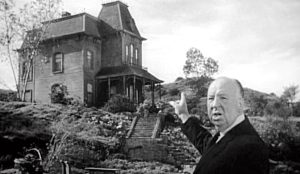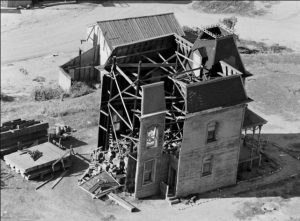
Movie Houses: Psycho
There are few movies where a single building can create the atmosphere required to set the scene for an entire film. Some that do: the isolated Timberline Lodge in Oregon (standing in as the Overlook Hotel in 1980’s The Shining); the large Dutch Colonial house at 112 Ocean Avenue (1979’s The Amityville Horror), and the J Paul Getty home used as Gloria Swanson’s decaying renaissance mansion on Sunset Boulevard (1950).
 When properly presented and with the right creative team, a building can become the movie’s centerpiece, setting the stage on which the actors perform. The Gothic Italianate styled house in 1960s Psycho however, with its weathered siding and mansard roofed tower, perched threateningly on a lonely hill, is the crown jewel of such movie houses. This house doesn’t just present a backdrop for the action, it is an ominous ever-present threat, representing the silent mother – judging, controlling and always watching. As so, the house itself becomes a character in the movie. One has to wonder if that is what Alfred Hitchcock had originally envisioned when directing the movie, or if it just worked out that way. The actual house, its history and how it’s been used over the years is an interesting story.
When properly presented and with the right creative team, a building can become the movie’s centerpiece, setting the stage on which the actors perform. The Gothic Italianate styled house in 1960s Psycho however, with its weathered siding and mansard roofed tower, perched threateningly on a lonely hill, is the crown jewel of such movie houses. This house doesn’t just present a backdrop for the action, it is an ominous ever-present threat, representing the silent mother – judging, controlling and always watching. As so, the house itself becomes a character in the movie. One has to wonder if that is what Alfred Hitchcock had originally envisioned when directing the movie, or if it just worked out that way. The actual house, its history and how it’s been used over the years is an interesting story.
Alfred Hitchcock got the idea for Psycho from his assistant, Peggy Robertson who, after reading the novel, convinced him to purchase the rights to Robert Bloch‘s 1959 book. Hitchcock paid $9,500 for the rights even after learning Paramount Pictures had previously rejected the manuscript. Although Hitchcock’s contract with Paramount guaranteed one more film, Paramount executives were against the project and refused to provide his usual budget. Paramount even went so far as to claim their sound stages were booked so they could not accommodate production. At the time of the negotiations however, the industry was in somewhat of a slump with many of Paramount’s sound stages standing empty.
To get around these roadblocks, Hitchcock offered to personally finance the project and to film it at Universal-International using the Revue Studios crew from his “Alfred Hitchcock Presents” television show. He needed Paramount only for distribution. In lieu of his usual $250,000 director’s fee, he proposed a 60% stake in the film negative. This reduced offer was accepted and Hitchcock proceeded to film. It was an agreement which ended up quite beneficial to both parties.
An interesting side note, once Hitchcock had secured the rights to Psycho, he reportedly directed his assistant to buy up all available copies of the book to ensure the story’s key plot points were only known to few, thereby maintaining the movies’ shock value.
The original novel by Robert Bloch was based on the true story of Ed Gein, a 51 year-old serial killer who lived in an isolated farm house in Plainfield Wisconsin. Mr. Gein had a penchant for women whom his mother had continuously condemned as “evil”. He often dressed in the clothes of his victims (or apparel fashioned from their body parts) and had one sealed room in his house, his deceased mother’s room, a woman he adored. The Gein’s house was a simple, somewhat rundown, two story farm house, nothing like the dramatic house portrayed in the movie.
The style of the “Bates” house in the movie needed to be more ominous. It was modeled on Edward Hopper‘s 1925 painting “The House by the Railroad”, a portrait of a Victorian home and an actual house still located at 18 Conger Avenue in Haverstraw, New York. The original painting presently hangs at New York City’s Museum of Modern Art (MoMA).
As the 1960 film was financed by Hitchcock himself, the entire production needed to be completed on a very tight budget. This led to a number of decisions which inadvertently added to the movie’s success. This included filming in black and white rather than in colour. By filming at Universal Studios, Hitchcock had access to the entire back lot – sets, costumes, etc. and this included components necessary for the construction of both the infamous “Psycho” house and the adjoining hotel. This unlimited access helped to stretch his meager budget of $807,000, which Hitchcock financed primarily by mortgaging his own home.
 The main components of the Bate’s house were created by utilizing elements of existing houses on the backlot’s Colonial Street. The House was built strictly as a set with 2 walls, the only two walls ever shown in the movie: the front and left facades which limited angles to which the dwelling could be filmed.
The main components of the Bate’s house were created by utilizing elements of existing houses on the backlot’s Colonial Street. The House was built strictly as a set with 2 walls, the only two walls ever shown in the movie: the front and left facades which limited angles to which the dwelling could be filmed.
The iconic portions of the building that was to become known as “The Psycho House” were initially built for the 1946 movie ‘So Goes My Love’ where it was built on a soundstage before being moved to Paramount’s Colonial Street. The house has been seen in a great number of other movies and television shows, including: “Harvey” with James Stewart (1950) as the Dowd house; and as the old Simmons Mansion in “The Ghost and Mr. Chicken” (1966) with Don Knotts, among many others. In fact, Hitchcock, himself, used his house and motel facade in his own TV series, “Alfred Hitchcock Presents”. First, he used it in a 1965 episode entitled “An Unlocked Window” in which stranded nurses trapped in the house are terrorized by a “psycho” trying to get in (a plot which does have a familiar ring to it). And later, the Bates Motel set was used in Alfred Hitchcock’s final TV show; an episode entitled “Off Season”.
Psycho had a number of sequels and a television series, some of which utilized the original Bates house:
- “Psycho II” (1983) The original house set was used and the motel was reconstructed for the film. Interesting note: the original shower head used in “Psycho” was to have been used in this film. However, just before filming, it was stolen from the set.
- “Psycho III” (1986) was filmed at the original house
- Psycho IV: The Beginning (1988) a prequel to the original movie utilizing a newly constructed Psycho House and Motel in Orlando, Florida
- Additionally in 2013, Netflix debuted a series based upon Psycho entitled “Bates Motel” which is now running in its 5th season
A comprehensive listing of the numerous movies, television programs and series which have incorporated the Psycho House, including: several episodes of “Boris Karloff’s Thriller”; the Ann-Margaret movie, “Kitten With A Whip” (1964); “Night Gallery” (1971);“The Nude Bomb” (1980); “Murder She Wrote” and (many) more, can be found here.